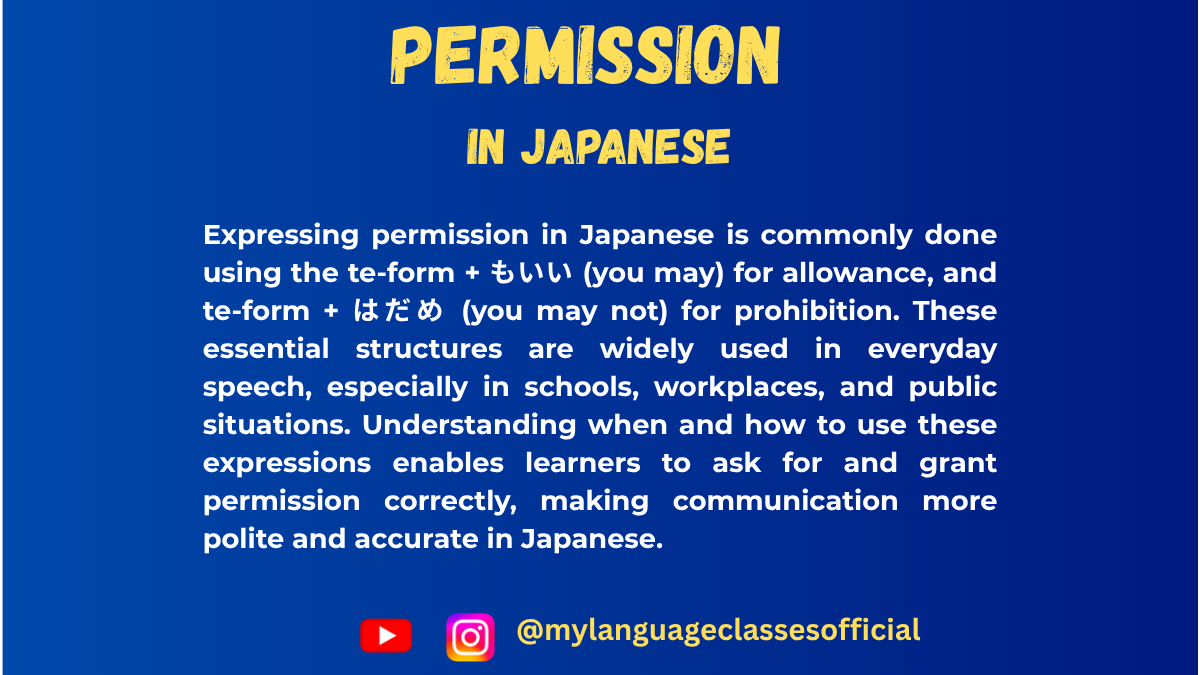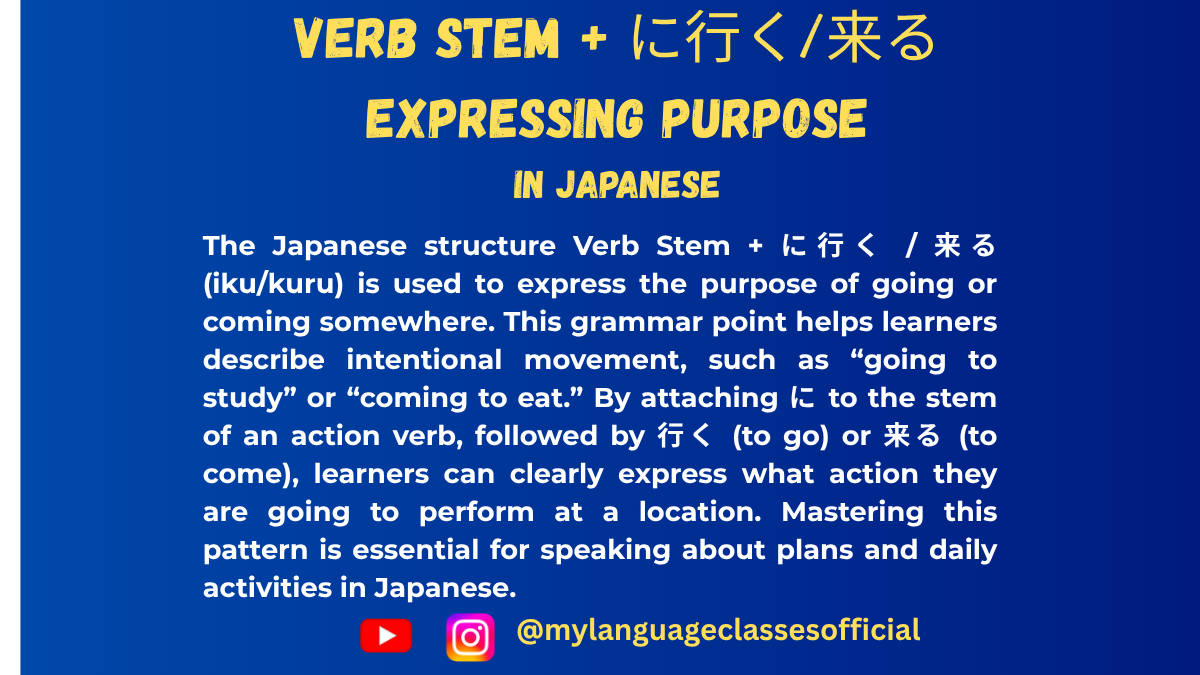Your cart is currently empty!
Tag: Japanese phrases
-
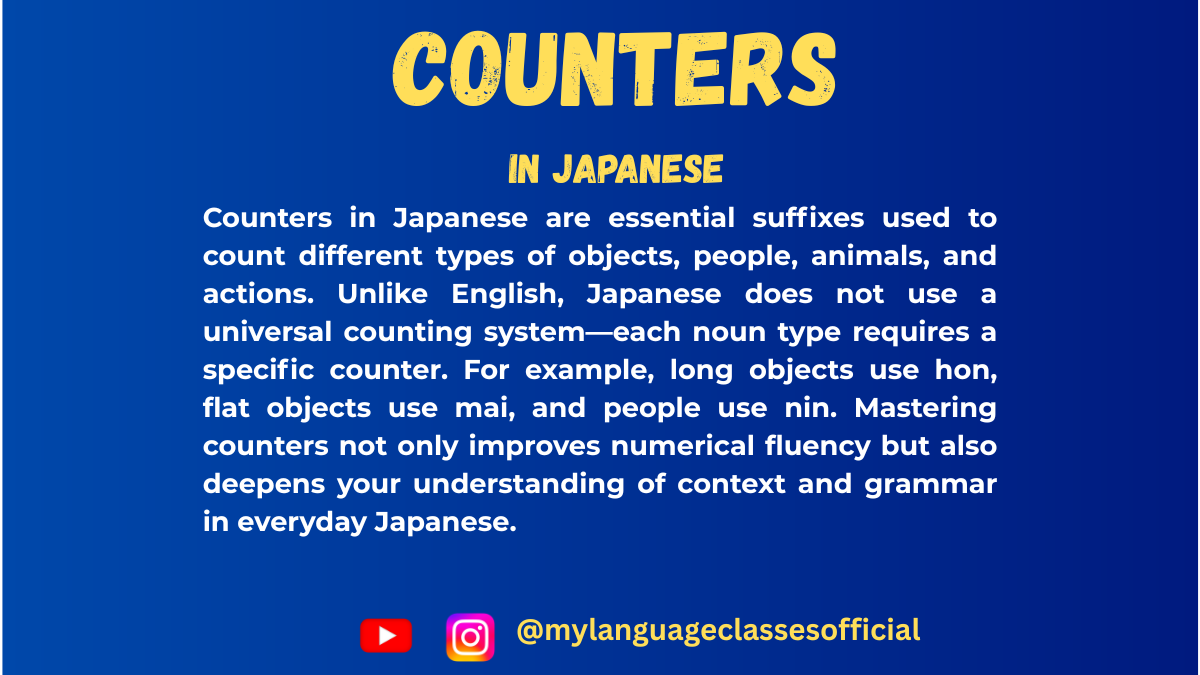
Mastering Japanese Counters | My Language Classes
Mastering Japanese Counters
When learning Japanese, one unique and challenging aspect for learners is the use of counters. Unlike English, Japanese uses specific words when counting objects, animals, people, and even abstract concepts. These counters change depending on the type and shape of the item being counted. In this post, we’ll delve deep into the world of Japanese counters, explain the logic behind them, and provide tips to use them confidently in everyday conversation.
What Are Counters in Japanese?
Counters are suffixes used to indicate the type or category of the item being counted. For example:
- 本 (ほん) is used for long, cylindrical objects like bottles or pencils.
- 枚 (まい) is for thin, flat objects like paper or plates.
- 匹 (ひき) is for animals like cats or fish.
To count items, you combine a number with the appropriate counter, often modifying the pronunciation depending on the number.
Basic Structure
The typical structure is:
Number + Counter
Examples:
- 一本 (いっぽん) — one pen (using the counter for long objects)
- 三枚 (さんまい) — three sheets of paper (using the counter for flat objects)
- 五匹 (ごひき) — five dogs (using the counter for animals)
However, it’s important to know irregular pronunciations, which often occur with numbers like 1, 3, 6, and 8. We’ll discuss this in detail below.
Common Counters and Their Usage
Here are some of the most frequently used counters:
1. General Items: 個 (こ)
Used for small, generic objects.
- Examples: 一個 (いっこ) — one piece, 三個 (さんこ) — three pieces.
2. Long Objects: 本 (ほん)
Used for items like pens, bottles, trees, and trains.
- Irregular pronunciations:
- 1本 (いっぽん)
- 3本 (さんぼん)
- 6本 (ろっぽん)
3. Flat Objects: 枚 (まい)
Used for items like paper, plates, and T-shirts.
- Examples: 一枚 (いちまい) — one sheet, 十枚 (じゅうまい) — ten sheets.
4. People: 人 (にん)
Used for counting people, with some exceptions:
- 1 person: 一人 (ひとり)
- 2 people: 二人 (ふたり)
- 3 or more: Regular pattern (三人 [さんにん], etc.).
5. Animals: 匹 (ひき)
Used for small animals like cats, dogs, and fish.
- Irregular pronunciations:
- 1匹 (いっぴき)
- 3匹 (さんびき)
- 6匹 (ろっぴき)
6. Books and Magazines: 冊 (さつ)
Used for bound objects like books and notebooks.
- Irregular pronunciations:
- 1冊 (いっさつ)
- 8冊 (はっさつ)
7. Machines and Vehicles: 台 (だい)
Used for cars, TVs, and other machinery.
- Examples: 一台 (いちだい), 五台 (ごだい).
8. Large Animals: 頭 (とう)
Used for cows, horses, and elephants.
- Examples: 一頭 (いっとう), 三頭 (さんとう).
Tips to Master Counters
- Start with Common Counters: Focus on frequently used counters like 個, 本, and 枚 before delving into specialized ones.
- Memorize Irregular Forms: Pay attention to irregular readings for numbers like 1, 3, 6, and 8.
- Practice with Real-Life Examples: Use counters in context, like ordering food or describing objects around you. For instance:
- レストランで: コーヒーを二杯 (にはい)ください (At a restaurant: “Two cups of coffee, please.”).
- Watch Native Speakers: Listen to native speakers to understand how counters are naturally used in conversation.
Things to Keep in Mind
- Context Matters: The appropriate counter often depends on the item’s size, shape, or category.
- Colloquial Shortcuts: In casual conversation, native speakers may drop the counter altogether if the context is clear:
- Example: りんご三つ (みっつ) instead of 三個.
- Counters for Abstract Concepts: Words like 回 (かい) for times or 度 (ど) for occurrences can be tricky. Practice distinguishing them:
- 一回 (いっかい) — once
- 一度 (いちど) — one time (but often implies a more formal or singular occasion).
Learning Through Examples
Here are some sample sentences to see counters in action:
- Books and Magazines:
- 本を三冊買いました。
(ほんをさんさつかいました)
I bought three books.
- 本を三冊買いました。
- Animals:
- 犬が五匹います。
(いぬがごひきいます)
There are five dogs.
- 犬が五匹います。
- Drinks:
- ビールを二杯ください。
(びーるをにはいください)
Two beers, please.
- ビールを二杯ください。
- People:
- 学生が十人来ました。
(がくせいがじゅうにんきました)
Ten students came.
- 学生が十人来ました。
Practice Makes Perfect
To truly master Japanese counters, practice is essential. Start by identifying objects around you and attaching the appropriate counter. Here’s a challenge for you:
- Look around your room and count:
- Books (冊)
- Pens (本)
- Chairs (台)
- Photos (枚).
By incorporating counters into daily life, you’ll quickly become more comfortable and natural when speaking Japanese.
Final Thoughts
Japanese counters can feel overwhelming at first, but they also add precision and beauty to the language. By focusing on common counters, practicing regularly, and immersing yourself in authentic Japanese content, you’ll be able to master this unique aspect of Japanese in no time. Keep practicing, and don’t be afraid to make mistakes—they’re the stepping stones to fluency. 頑張ってね!(Good luck!)
If you enjoyed this lesson, be sure to check out more posts like this on my blog at My Language Classes. Don’t forget to subscribe my YouTube channel and follow me on Instagram for the latest language learning tips and lessons. Leave a comment below to share your thoughts, or ask any questions you have about nouns.
Happy learning! 😊
-
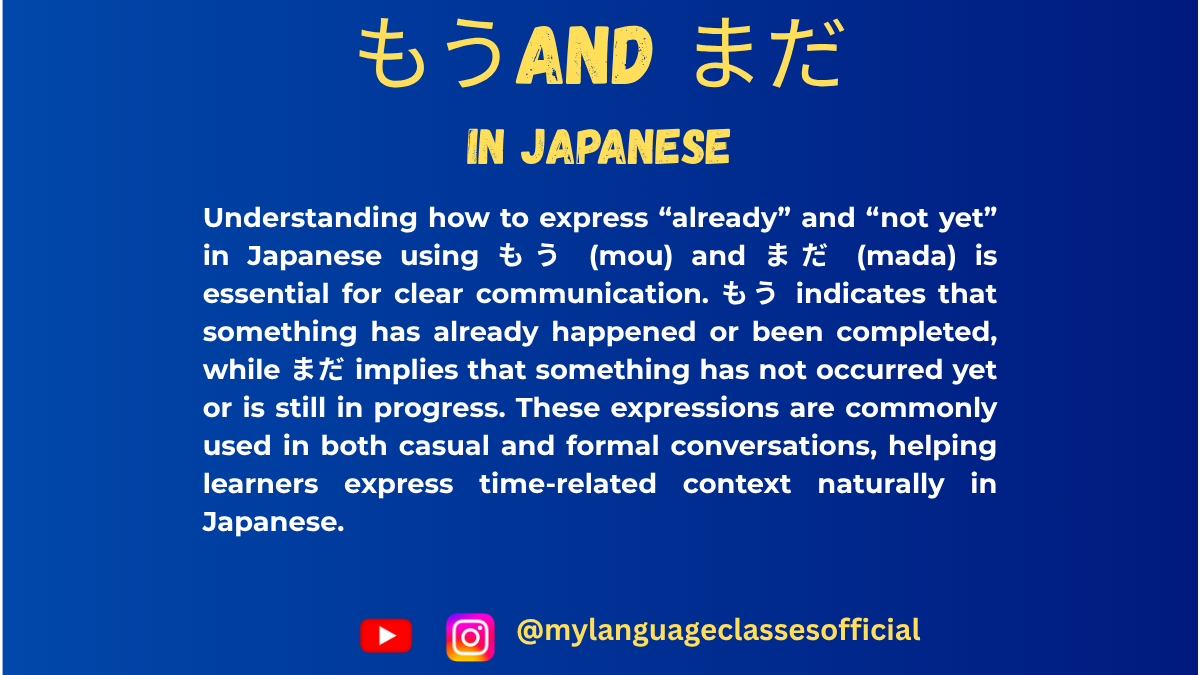
How to Say “Already” & “Not Yet” in Japanese もう and まだ | My Language Classes
Expressing “Already” and “Not Yet” in Japanese
When learning Japanese, one of the first challenges is understanding how to express “already” and “not yet.” In English, these concepts are simple, but in Japanese, we rely on two essential words: もう (mou) and まだ (mada). By the end of this post, you’ll master how to use these two expressions correctly and naturally.
1. Understanding もう (“Already”)
The word もう translates to “already” in English and is used to indicate that an action has already been completed or a state has been reached.
Examples of もう in Sentences
- もう食べました。
Mou tabemashita.
“I already ate.” - もう終わりましたか?
Mou owarimashita ka?
“Have you already finished?” - 彼はもう来ました。
Kare wa mou kimashita.
“He has already come.”
Key Point for もう:
- Use it with the past tense of a verb to show completion.
- It often expresses a sense of surprise or confirmation.
2. Understanding まだ (“Not Yet”)
On the other hand, まだ means “not yet” and expresses an action or state that has not happened or is still ongoing.
Examples of まだ in Sentences
- まだ食べていません。
Mada tabete imasen.
“I haven’t eaten yet.” - まだ終わっていない。
Mada owatte inai.
“It’s not finished yet.” - 彼はまだ来ていません。
Kare wa mada kite imasen.
“He hasn’t come yet.”
Key Point for まだ:
- Use it with the negative form of a verb.
- It implies that something is expected to happen or still in progress.
3. Using もう and まだ Together
To create a clear contrast, you can use もう and まだ in conversations:
- もう食べましたか?
Mou tabemashita ka?
“Have you already eaten?”- Answer (Yes): もう食べました。(Mou tabemashita.) – “I already ate.”
- Answer (No): まだ食べていません。(Mada tabete imasen.) – “I haven’t eaten yet.”
This contrast helps clarify whether something has already occurred or is still pending.
4. Common Expressions Using もう and まだ
Here are a few handy expressions that use these words:
- もういいです。 (Mou ii desu.) – “It’s okay now.” / “I’m done.”
- まだまだです。 (Mada mada desu.) – “I still have a long way to go.” (Often used humbly about one’s skills or progress.)
5. Summary: Quick Reference Table
Word Meaning Usage Example もう Already Past/Complete Actions もう行きました。 (Mou ikimashita.) – “I already went.” まだ Not Yet/Still Negative or Ongoing まだ行っていません。 (Mada itte imasen.) – “I haven’t gone yet.”
6. Practice Time!
Try filling in the blanks with もう or まだ:
- ( )宿題を終えましたか? (… shukudai o oemashita ka?)
“Have you finished your homework already?” - いいえ、( )終わっていません。
“No, I haven’t finished yet.”
Answers:
- もう
- まだ
By practicing もう and まだ, you’ll gain confidence in expressing whether something has “already” happened or “not yet.” Keep listening to native speakers and trying these phrases in daily conversation—まだまだ there’s plenty to learn, but you’re already doing great!
What do you think about these tips? Let me know if you もう understand or if you’re まだ unsure—leave a comment below! 😊
If you enjoyed this lesson, be sure to check out more posts like this on my blog at My Language Classes. Don’t forget to subscribe my YouTube channel and follow me on Instagram for the latest language learning tips and lessons. Leave a comment below to share your thoughts, or ask any questions you have about nouns.
Happy learning! 😊
- もう食べました。
-
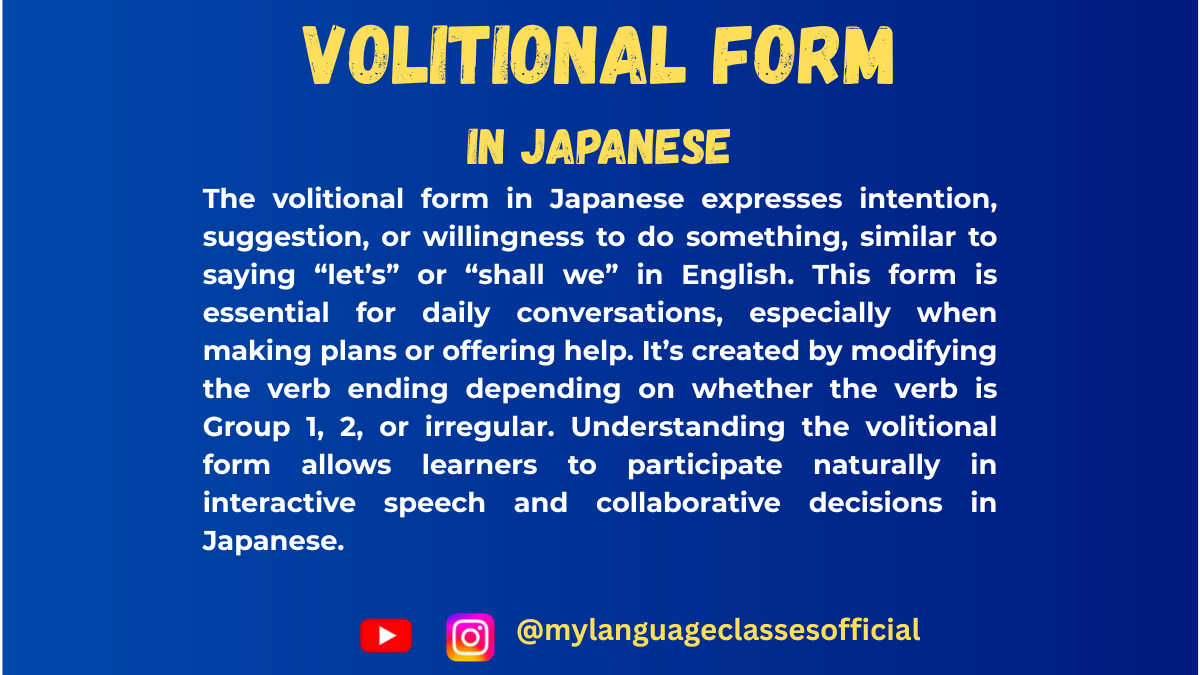
Understanding Volitional Form in Japanese | My Language Classes
Volitional Form in Japanese
The volitional form in Japanese is a versatile and essential grammatical structure. It’s often used to express intentions, suggestions, or invitations. Think of it as the Japanese equivalent of saying, “Let’s” or “Shall we?” in English.
This post will break it down into two main categories: the informal volitional form and the polite volitional form, making it easy for learners of all levels to grasp and apply.
1. The Informal Volitional Form
The informal volitional form is used casually among friends, family, or people you’re close to. It’s the shorter, more relaxed version of suggesting something.
How to Form It
The structure depends on whether the verb is a う-verb or a る-verb. Here’s how you can form the volitional form:
- For う-verbs: Replace the final う sound with おう.
- Example:
- 行く (iku – to go) → 行こう (ikou – Let’s go)
- 飲む (nomu – to drink) → 飲もう (nomou – Let’s drink)
- Example:
- For る-verbs: Drop the る and add よう.
- Example:
- 食べる (taberu – to eat) → 食べよう (tabeyou – Let’s eat)
- 見る (miru – to see/watch) → 見よう (miyou – Let’s watch)
- Example:
- Irregular verbs: These don’t follow the usual patterns and need to be memorized:
- する (suru – to do) → しよう (shiyou – Let’s do)
- 来る (kuru – to come) → 来よう (koyou – Let’s come)
When to Use It
Use the informal volitional form in casual contexts:
- Planning something with friends:
- 映画を見よう! (Eiga o miyou! – Let’s watch a movie!)
- Deciding something for yourself:
- もっと頑張ろう。 (Motto ganbarou. – I’ll try harder.)
2. The Polite Volitional Form
For more formal situations, the polite volitional form is used. This is especially common in workplaces, public settings, or when speaking to superiors or strangers.
How to Form It
The polite volitional form follows a straightforward rule:
- Take the stem of the verb and add ましょう.
- Example:
- 行く (iku – to go) → 行きましょう (ikimashou – Let’s go)
- 食べる (taberu – to eat) → 食べましょう (tabemashou – Let’s eat)
When to Use It
Use the polite volitional form in formal or respectful contexts:
- Inviting someone politely:
- 一緒に昼ご飯を食べましょうか? (Issho ni hiru gohan o tabemashou ka? – Shall we have lunch together?)
- Offering a suggestion in a business setting:
- 次のステップを考えましょう。 (Tsugi no suteppu o kangaemashou. – Let’s think about the next step.)
3. Key Differences Between Informal and Polite Forms
Aspect Informal Volitional Form Polite Volitional Form Tone Casual Formal/Respectful Ending おう/よう Verb stem + ましょう Usage Context Friends, family Business, public, formal
4. Practice Makes Perfect!
Here are a few sentences to test your understanding. Try converting them into both informal and polite volitional forms:
- 泳ぐ (oyogu – to swim)
- 話す (hanasu – to talk)
- 勉強する (benkyou suru – to study)
Answers:
- 泳ぐ: 泳ごう / 泳ぎましょう
- 話す: 話そう / 話しましょう
- 勉強する: 勉強しよう / 勉強しましょう
By mastering the volitional form, you’ll be well on your way to expressing intentions and making suggestions naturally in Japanese. Practice using these forms in conversations, and soon they’ll become second nature. 頑張りましょう! (Ganbarimashou! – Let’s do our best!)
If you enjoyed this lesson, be sure to check out more posts like this on my blog at My Language Classes. Don’t forget to subscribe my YouTube channel and follow me on Instagram for the latest language learning tips and lessons. Leave a comment below to share your thoughts, or ask any questions you have about nouns.
Happy learning! 😊
- For う-verbs: Replace the final う sound with おう.
-
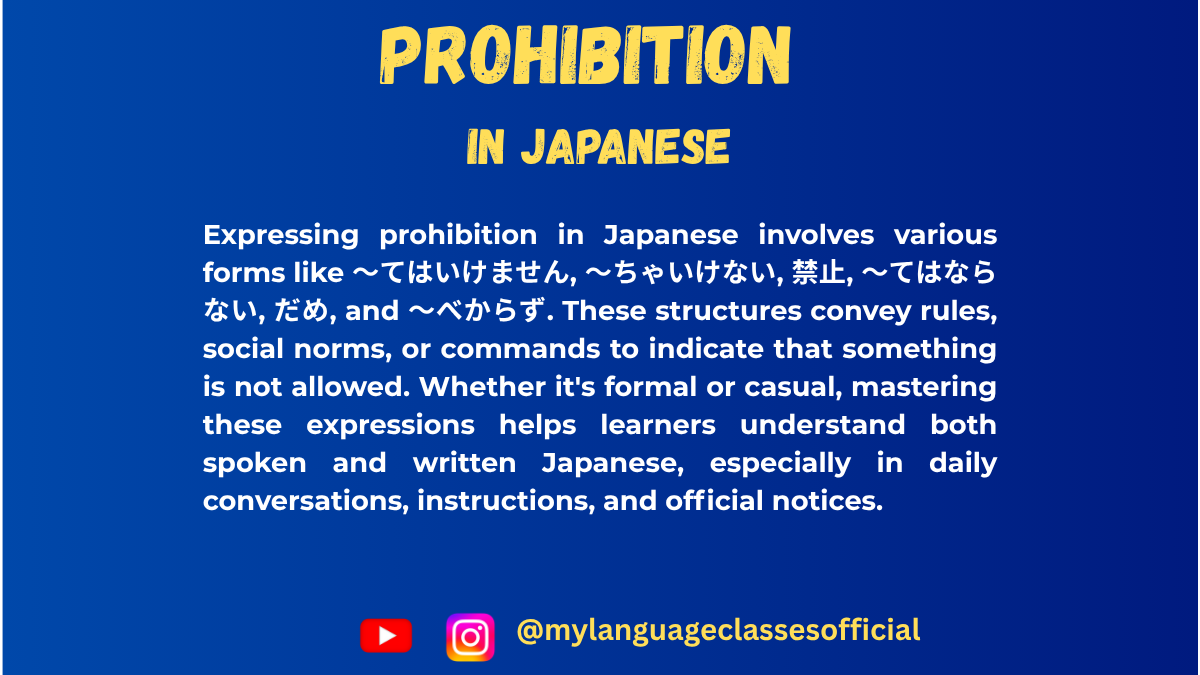
How to Express Prohibition in Japanese | My Language Classes
Expressing Prohibition in Japanese
If you’re learning Japanese, mastering how to express prohibition (saying what cannot or should not be done) is an essential step toward fluency. Japanese has a rich tapestry of expressions for prohibition, each carrying different nuances based on politeness levels, context, and the strength of the prohibition. In this blog, I’ll guide you through the most common ways to express prohibition in Japanese and help you understand when to use them.
1. ~てはいけません (Te wa ikemasen)
This is one of the most commonly used and polite ways to express prohibition in Japanese. It translates roughly to “You must not…” or “It’s not allowed to…”.
Formation:
Take the te-form of the verb and attach ~てはいけません.
Example:
- ここでたばこを吸ってはいけません。
(Koko de tabako o sutte wa ikemasen.)
“You must not smoke here.”
This phrase is often used in formal situations, such as school rules, workplace guidelines, or signs in public spaces.
2. ~ちゃダメ / ~ちゃいけない (Casual Forms)
In casual settings, Japanese speakers often use ~ちゃダメ or ~ちゃいけない to express prohibition. These are informal contractions of ~てはいけません.
Example:
- ここでゲームしちゃダメだよ。
(Koko de geemu shicha dame da yo.)
“You can’t play games here.” - あそこで走っちゃいけない。
(Asoko de hashiccha ikenai.)
“You must not run over there.”
Use these with close friends, family members, or peers, but avoid them in formal contexts.
3. 禁止 (Kinshi) – The Formal, Written Prohibition
When expressing prohibition in written form, especially on signs or official notices, the word 禁止 (kinshi, meaning “prohibited”) is frequently used.
Example:
- 飲酒禁止 (Inshu kinshi)
“Drinking alcohol is prohibited.” - 駐車禁止 (Chuusha kinshi)
“No parking.”
This construction is direct and impersonal, commonly used in public spaces to state clear rules.
4. ~てはならない (Te wa naranai)
This is a more formal and literary way of expressing prohibition. It is less common in daily conversation but can be seen in legal documents or formal writings.
Example:
- 嘘をついてはならない。
(Uso o tsuite wa naranai.)
“You must not tell lies.”
5. Use of だめ (Dame)
The word だめ (dame) itself means “no good,” “not allowed,” or “forbidden.” It’s highly versatile and can stand alone as an expression of prohibition.
Examples:
- それはだめです。 (Sore wa dame desu.)
“That’s not allowed.” - 今はだめ。 (Ima wa dame.)
“Not now.”
Depending on the tone and situation, だめ can range from strict to soft and conversational.
6. ~べからず (Bekarazu) – Traditional and Strict
This archaic phrase is rarely used in modern conversation but appears in traditional, formal, or poetic contexts.
Example:
- 立ち入りべからず。
(Tachiiri bekarazu.)
“No trespassing.”
It carries an old-fashioned and authoritative tone, reminiscent of samurai-era language.
Choosing the Right Expression
When deciding how to express prohibition in Japanese, consider the following factors:
- Formality: Use ~てはいけません for polite conversations and signs, and ~ちゃダメ for casual settings.
- Authority: Use 禁止 or ~てはならない for official or serious prohibitions.
- Audience: Adapt your language based on whether you’re speaking to a friend, a stranger, or a group.
Practice Makes Perfect!
Understanding prohibition in Japanese is only the first step; using it naturally requires practice. Try creating your own sentences using these structures, and pay attention to how native speakers use them in real life. The more you immerse yourself, the more intuitive these expressions will become.
So, what are you waiting for? Share your practice sentences in the comments, and let’s refine your skills together!
あなたはどの禁止表現をよく使いますか?コメントで教えてください!
(Anata wa dono kinshi hyougen o yoku tsukaimasu ka? Komento de oshiete kudasai!)
Which prohibition expression do you use most often? Let me know in the comments!
If you enjoyed this lesson, be sure to check out more posts like this on my blog at My Language Classes. Don’t forget to subscribe my YouTube channel and follow me on Instagram for the latest language learning tips and lessons. Leave a comment below to share your thoughts, or ask any questions you have about nouns.
Happy learning! 😊
- ここでたばこを吸ってはいけません。
-
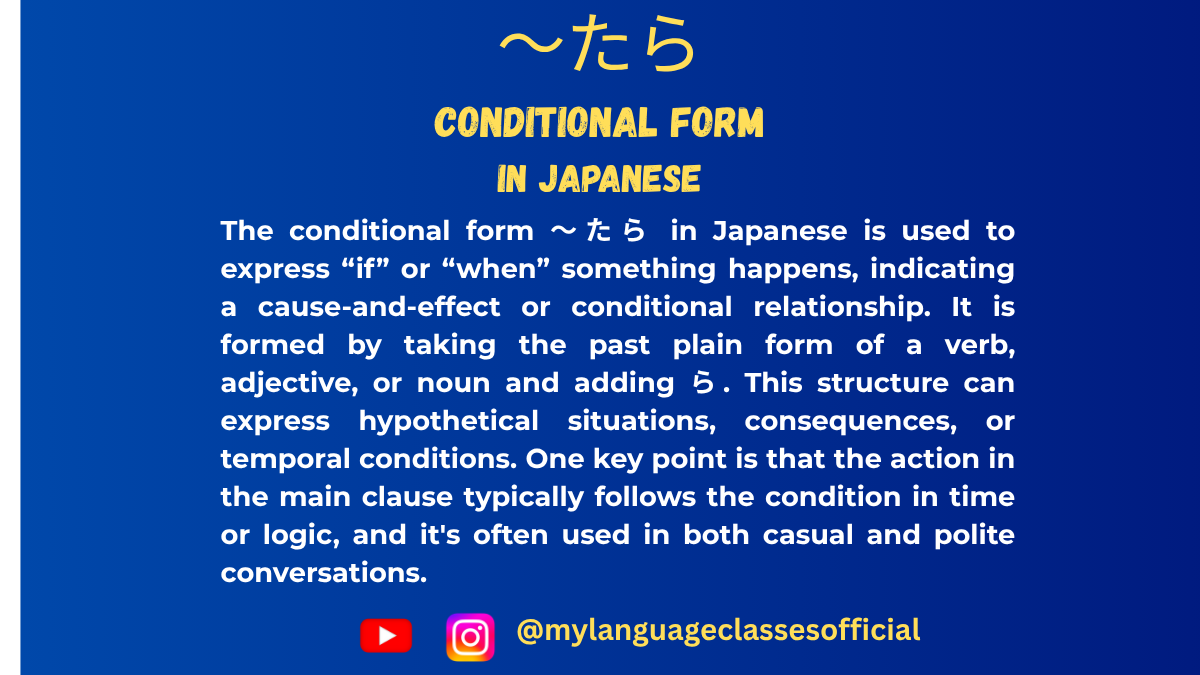
Understanding Conditional form ~たら in Japanese | My Language Classes
Understanding ~たら in Japanese
Learning Japanese grammar often feels like solving a puzzle, where each piece contributes to your fluency. One such critical piece is the ~たら structure, a conditional form that translates roughly to “if” or “when” in English. In this blog post, we’ll break down how to use ~たら effectively, covering its structure, usage, and nuances, along with examples to boost your confidence.
What is ~たら?
The ~たら structure comes from the past tense form of a verb, adjective, or noun, combined with ら (ra). It’s used to express conditional situations, which means it helps us talk about “if” or “when” something happens.
Key Functions of ~たら:
- Expressing Conditions: “If X happens, then Y will occur.”
- Temporal Sense: “When X happens, Y will follow.”
This dual meaning is a hallmark of ~たら, and context determines whether it means “if” or “when.”
The Structure of ~たら
Let’s look at how to form ~たら for different word types:
1. Verbs
- Take the plain past tense form (た-form) of the verb + ら.
- Example:
食べる → 食べた → 食べたら (if/when [I] eat)
2. Adjectives
- For い-adjectives, replace the final い with かったら.
- Example: 高い → 高かった → 高かったら (if/when [it’s] expensive)
- For な-adjectives, use the structure: adjective + だったら.
- Example: 静か → 静かだったら (if/when [it’s] quiet)
3. Nouns
- Combine the noun with だったら.
- Example: 休み → 休みだったら (if/when [it’s] a holiday)
Usage Examples
Let’s explore ~たら in action, both as “if” and “when.”
1. Conditional “If”
- 日本に行ったら、寿司を食べたいです。
(Nihon ni ittara, sushi o tabetai desu.)
If I go to Japan, I want to eat sushi. - 時間があったら、映画を見ましょう。
(Jikan ga attara, eiga o mimashou.)
If we have time, let’s watch a movie.
Here, the meaning hinges on a hypothetical condition being met.
2. Temporal “When”
- 家に帰ったら、宿題をします。
(Ie ni kaettara, shukudai o shimasu.)
When I get home, I’ll do my homework. - 雨がやんだら、公園で遊びましょう。
(Ame ga yandara, kouen de asobimashou.)
When the rain stops, let’s play at the park.
In these examples, ~たら conveys a temporal relationship, emphasizing a sequence of events.
Nuances and Tips
- Avoid Overlapping ~たら with ~と or ~ば
While ~と and ~ば also express conditions, ~たら is more versatile because it handles both “if” and “when.” However, ~と is more deterministic (e.g., water boils when heated), and ~ば can feel more formal or speculative. - Expressing Surprise or Discovery
~たら is also used to convey unexpected results:- ドアを開けたら、猫がいました。
(Doa o aketara, neko ga imashita.)
When I opened the door, there was a cat.
Here, the speaker did not anticipate finding a cat.
- ドアを開けたら、猫がいました。
- Avoid Using ~たら for Certainties
If an event is guaranteed to occur (e.g., the sun rising), use a temporal marker like ~時 instead of ~たら.
Practice Time!
Try making your own sentences using ~たら. Here are some prompts to get you started:
- What would you do if you won the lottery?
宝くじに当たったら、______。 - What will you do when the weekend comes?
週末になったら、______。
Share your answers in the comments or with your language partner. Practice makes perfect!
Final Thoughts
The ~たら structure is a cornerstone of Japanese conditional grammar. By mastering it, you’ll unlock the ability to express complex ideas about possibilities and sequences. Remember to pay attention to context to distinguish between “if” and “when,” and don’t hesitate to experiment with it in your conversations.
Ready to elevate your Japanese skills? Try using ~たら today!
If you enjoyed this lesson, be sure to check out more posts like this on my blog at My Language Classes. Don’t forget to subscribe my YouTube channel and follow me on Instagram for the latest language learning tips and lessons. Leave a comment below to share your thoughts, or ask any questions you have about nouns.
Happy learning! 😊
-
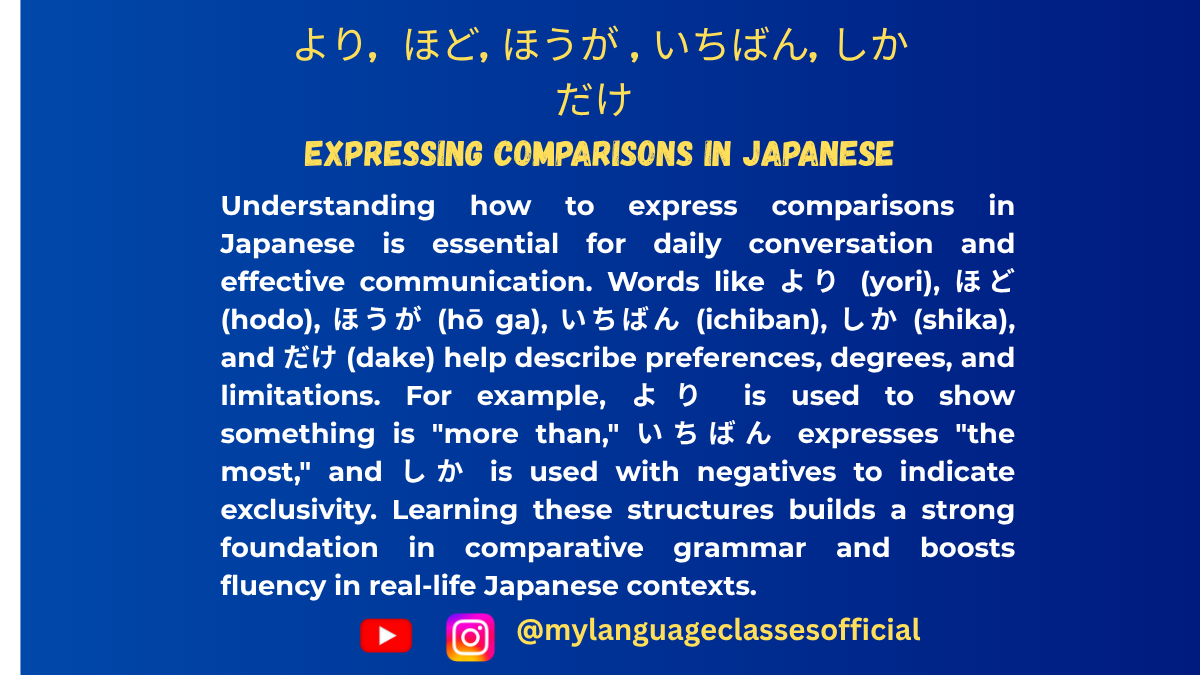
Mastering Comparisons in Japanese より, ほど, ほうが, いちばん, しか, and だけ | My Language Classes
Expressing Comparisons in Japanese より, ほど, ほうが, いちばん, しか, and だけ
When learning Japanese, one of the most important concepts is mastering the art of comparisons. Whether you’re talking about how something is “better” or “more” than something else, or simply stating your preference, knowing how to compare effectively helps you express yourself clearly and confidently. In this post, we’ll cover some of the most essential comparison structures in Japanese: より (more than), ほど (more than / to the extent of), ほうが (preference), いちばん (the most), and dive into important distinctions such as より vs ほど and だけ vs しか.
1. より (More Than)
The particle より is used when comparing two items, indicating that one is more than the other. It’s the most straightforward way to show superiority or difference between two things.
Example:
- この映画はあの映画より面白いです。
Kono eiga wa ano eiga yori omoshiroi desu.
This movie is more interesting than that movie.
Here, より is used to compare the two movies, with the first one being more interesting than the second.
2. ほど (More Than / To the Extent of)
ほど is used to express a comparison where something is “more than” another thing, but with a focus on degree or extent. It’s often used when talking about how much more of something there is, especially in terms of actions or abilities.
Example:
- 彼は私ほど速く走れません。
Kare wa watashi hodo hayaku hashiremasen.
He can’t run as fast as I can.
Here, ほど is used to emphasize the difference in the degree of speed. It’s not just “more than” in quantity, but more in terms of ability or extent.
3. より vs ほど (Key Difference)
While both より and ほど can be translated as “more than,” the distinction lies in their nuance:
- より is used for simple comparisons, where one thing is greater or superior than another in a more straightforward sense.
- ほど is used when discussing the degree or extent of a comparison, often involving abilities, qualities, or actions. It can also suggest “to the extent that” or “as much as.”
Example:
- 彼は私より背が高いです。
Kare wa watashi yori se ga takai desu.
He is taller than I am.
(Simple comparison) - 彼は私ほど速く走れません。
Kare wa watashi hodo hayaku hashiremasen.
He can’t run as fast as I can.
(Degree of ability comparison)
4. ほうが (Preference)
The structure ほうが is used to express preference between two things, indicating that one thing is favored over the other.
Example:
- 日本の映画はアメリカの映画より面白いほうが好きです。
Nihon no eiga wa Amerika no eiga yori omoshiroi hō ga suki desu.
I prefer Japanese movies over American movies because they are more interesting.
In this sentence, ほうが emphasizes the preference for Japanese movies compared to American movies.
5. いちばん (The Most)
いちばん is used to indicate the highest degree of something, meaning “the most” or “the best.” It’s used when something stands out as the most in a particular category.
Example:
- 彼女はクラスでいちばんかわいいです。
Kanojo wa kurasu de ichiban kawaii desu.
She is the most beautiful in the class.
Here, いちばん is used to express that she is the top or number one in terms of beauty.
6. だけ (Only) vs しか (Only, but Negative)
Another pair worth noting in comparisons is だけ and しか. Both can be translated as “only,” but the way they are used is quite different.
- だけ is used to indicate a positive statement or simple limitation.Example:
- このレストランには寿司だけがあります。
Kono resutoran ni wa sushi dake ga arimasu.
This restaurant only has sushi.
- このレストランには寿司だけがあります。
- しか is used with a negative verb, indicating “only” but with the sense that there is nothing more than that (often implying something less than expected).Example:
- このレストランには寿司しかありません。
Kono resutoran ni wa sushi shika arimasen.
This restaurant only has sushi (and nothing else).
- このレストランには寿司しかありません。
Notice that with しか, a negative verb is required, while with だけ, the statement can be positive.
Tips for Mastering Comparisons
- Understand the Context: Pay attention to whether you’re making a straightforward comparison or discussing degrees of difference. This will help you choose between より and ほど.
- Practice with Real-Life Examples: Try comparing things you see around you. For example, compare two foods, two movies, or two places. This helps you internalize comparison structures.
- Use ほうが for Preferences: If you’re ever unsure about how to express a preference, use ほうが. It’s a simple way to show that you favor one thing over another.
- Avoid Overcomplicating Things: Don’t worry about using every comparison structure at once. Focus on mastering one at a time—start with より and いちばん, then gradually incorporate ほど and ほうが into your conversations.
- Listen to Native Speakers: Pay attention to how native speakers make comparisons. Listening to their natural flow will help you understand which structure to use in various situations.
Final Thoughts: Mastering Comparisons for Fluent Communication
Mastering comparisons in Japanese is a crucial step toward fluency. By understanding how to use より (more than), ほど (more than / to the extent of), ほうが (preference), and いちばん (the most), you’ll be able to express differences, preferences, and extremes with precision and confidence.
Remember that the key to becoming proficient in any aspect of a language is practice. The more you engage with these comparison structures in your speaking and writing, the more natural they will feel.
So, keep practicing, stay curious, and challenge yourself to use comparisons in your everyday conversations. With continued effort and attention to detail, you’ll be able to navigate the nuances of Japanese comparisons and speak like a native speaker in no time. Happy learning!
If you enjoyed this lesson, be sure to check out more posts like this on my blog at My Language Classes. Don’t forget to subscribe my YouTube channel and follow me on Instagram for the latest language learning tips and lessons. Leave a comment below to share your thoughts, or ask any questions you have about nouns.
Happy learning! 😊
- この映画はあの映画より面白いです。
-

Understanding ある vs いる Japanese Existence Verbs | My Language Classes
Japanese Existence Verbs: ある (Aru) vs いる (Iru)
In Japanese, one of the fundamental concepts is the idea of existence, or being. Just like in any language, expressing whether something exists or is present is crucial to communication. In Japanese, this is expressed using two key verbs: ある (aru) and いる (iru).
Though both words translate as “to be” or “to exist,” their usage depends on the type of subject you’re referring to. This difference can be tricky for learners, but once you grasp it, you’ll find yourself speaking more naturally in Japanese.
1. ある (Aru) — Used for Inanimate Objects or Abstract Concepts
The verb ある (aru) is used to express the existence of inanimate objects, things, places, or abstract concepts. If the subject is something that doesn’t have life (like a chair, book, or idea), ある is the correct verb to use.
Examples:
- 本がある。
(Hon ga aru)
“There is a book.” - 学校がある。
(Gakkou ga aru)
“There is a school.”
(Literally, “A school exists.”) - 問題がある。
(Mondai ga aru)
“There is a problem.”
(Literally, “A problem exists.”)
As you can see, ある applies to non-living things—whether they are physical objects, places, or even abstract ideas like problems or opportunities.
2. いる (Iru) — Used for Living Things
On the other hand, いる (iru) is used to indicate the existence of living things, such as people, animals, or any other beings that can move or have consciousness. This includes everything from pets to people to animals.
Examples:
- 犬がいる。
(Inu ga iru)
“There is a dog.”
(Literally, “A dog exists.”) - 先生がいる。
(Sensei ga iru)
“There is a teacher.”
(Literally, “A teacher exists.”) - 友達がいる。
(Tomodachi ga iru)
“I have friends.”
(Literally, “Friends exist.”)
The verb いる is also commonly used to refer to living things when you’re describing their existence in a particular place or context. It’s important to note that いる is for beings that can move, think, or live.
The Difference Between ある and いる
To put it simply:
- Use ある when talking about inanimate objects, things, or places.
- Use いる when talking about living things—people, animals, etc.
How to Make Sentences Negative: ない (Nai)
Just like with other verbs in Japanese, you can make sentences negative by adding ない (nai), which is the negative form of both ある and いる.
- ある becomes ない:
本がない。 (Hon ga nai) — “There is no book.” - いる becomes いない:
犬がいない。 (Inu ga inai) — “There is no dog.”
These negative forms are essential for talking about the absence of something or someone.
Other Uses of ある and いる
- Existence in the Past (だった / いた) Just like in English, we can also talk about past existence in Japanese. あった (atta) and いた (ita) are the past tense forms of ある and いる, respectively.
- 本があった。
(Hon ga atta)
“There was a book.” - 犬がいた。
(Inu ga ita)
“There was a dog.”
- 本があった。
- Describing Location Both ある and いる are also used when talking about the location of things or people. The particles に (ni) or で (de) are typically used to indicate where the subject exists.
- 机の上に本がある。
(Tsukue no ue ni hon ga aru)
“There is a book on the desk.” - 公園に犬がいる。
(Kouen ni inu ga iru)
“There is a dog in the park.”
- 机の上に本がある。
A Helpful Trick to Remember
A simple trick to remember the difference between ある and いる is to think of the phrase “Life is moving.”
- いる for living things = I for I (living being, me, you, animals).
- ある for inanimate things = A for A object.
This small mnemonic can help keep the two verbs straight as you practice!
Conclusion
Understanding ある (aru) and いる (iru) is an essential part of learning Japanese, as it helps you express existence in various contexts. Whether you’re talking about inanimate objects, people, animals, or abstract concepts, knowing when to use each verb will make your Japanese sound more fluent and natural.
If you’re new to learning Japanese, start practicing these verbs with simple sentences and gradually increase complexity. With a little practice, expressing existence will become second nature to you!
If you enjoyed this lesson, be sure to check out more posts like this on my blog at My Language Classes. Don’t forget to subscribe my YouTube channel and follow me on Instagram for the latest language learning tips and lessons. Leave a comment below to share your thoughts, or ask any questions you have about nouns.
Happy learning! 😊
- 本がある。
-
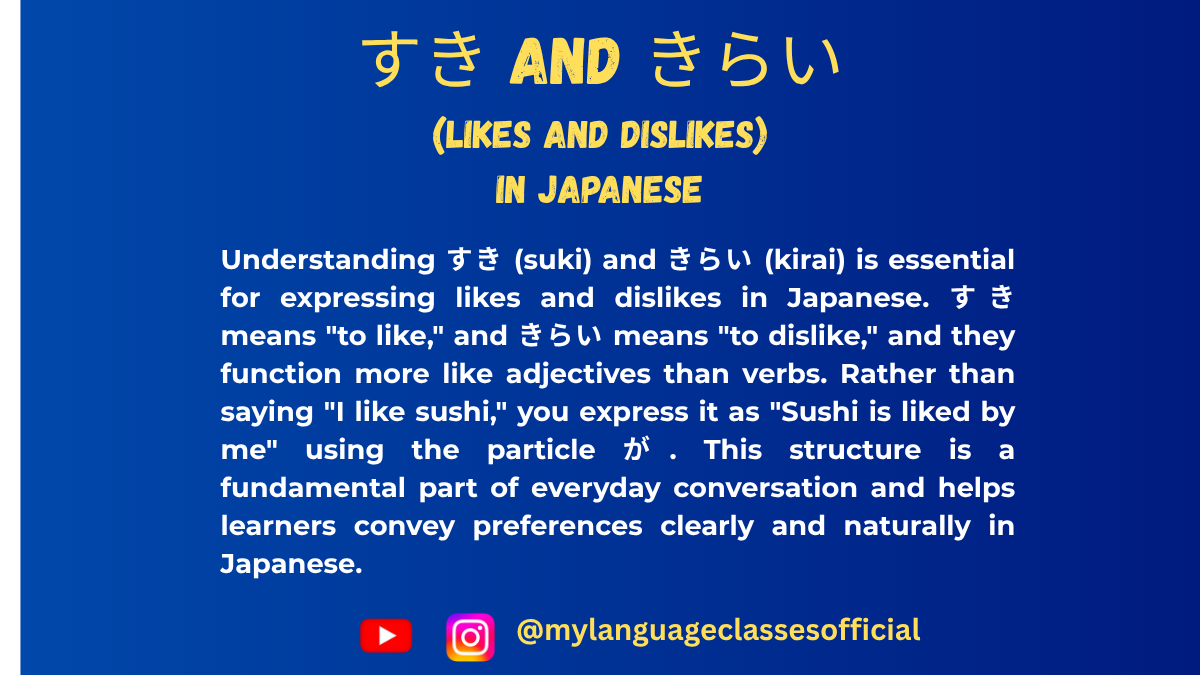
Expressing Likes and Dislikes すき and きらい in Japanese | My Language Classes
Likes and Dislikes in Japanese
こんにちは!(Konnichiwa!)
Learning how to express preferences is one of the most useful and fun parts of mastering Japanese. Today, let’s dive into two essential words: 好き (すき) for “like” and 嫌い (きらい) for “dislike.” Not only will we explore their meanings, but also how to use them naturally in sentences.
1. 好き (すき) – To Like
How to Use 好き
The word 好き means “like” or “fond of” and is commonly used to express your preferences. The structure is simple:
Noun + が好き
This translates to “I like [noun].”Examples:
- 日本語が好きです。
Nihongo ga suki desu.
I like Japanese.- Here, 日本語 (Nihongo) means “Japanese,” and が marks it as the topic you like. Adding です makes it polite.
- 犬が好き。
Inu ga suki.
I like dogs.- This informal version is common among friends or in casual settings.
Expressing Love or Passionate Likes
To emphasize your love or deep passion for something, you can use 大好き (だいすき/daisuki):
- チョコレートが大好きです!
Chokorēto ga daisuki desu!
I love chocolate!
2. 嫌い (きらい) – To Dislike
How to Use 嫌い
On the flip side, 嫌い means “dislike” or “hate.” The structure is the same as 好き:
Noun + が嫌い
This means “I dislike [noun].”Examples:
- ピザが嫌いです。
Piza ga kirai desu.
I dislike pizza.- ピザ (Piza) means “pizza.” While it’s a popular dish, some people might find it too greasy!
- 虫が嫌い。
Mushi ga kirai.
I hate insects.- 虫 (Mushi) refers to “insects.” Use this informal structure with friends.
Expressing Strong Dislike
If you strongly dislike something, you can say 大嫌い (だいきらい/daikirai):
- 雨が大嫌いです!
Ame ga daikirai desu!
I hate rain!
3. Cultural Notes
- “Softer Tone for Dislikes”: In Japanese culture, direct expressions of dislike like 嫌い might come off as too strong in some situations. To soften it, you can use phrases like:
- あまり好きじゃない (Amari suki janai) – “I don’t really like [it].”
- ちょっと苦手です (Chotto nigate desu) – “I’m a bit bad with [it].”
- Overuse of 好き: While 好き is positive, saying it too often might sound insincere. Balance your expressions to match the context.
4. Grammar and Nuance Tips
- No Verb Needed:
Both 好き and 嫌い function as な-adjectives, not verbs. This means they don’t need any conjugation or additional verbs to form basic sentences.Example:- Correct: 猫が好きです。 (Neko ga suki desu. – “I like cats.”)
- Incorrect: 猫が好きをです。 (Neko ga suki wo desu. – This is ungrammatical.)
- が (Ga) vs. は (Wa):
Although が is standard for these structures, は can be used for contrast or emphasis:- 犬は好きですが、猫は嫌いです。
Inu wa suki desu ga, neko wa kirai desu.
I like dogs, but I dislike cats.
- 犬は好きですが、猫は嫌いです。
5. Practice Time!
Let’s put what you’ve learned into action. Try completing these sentences:
- 私は ______ が好きです。
(Watashi wa ______ ga suki desu.)- Translate: “I like ______.”
- 友達は ______ が嫌いです。
(Tomodachi wa ______ ga kirai desu.)- Translate: “My friend dislikes ______.”
- ______ は大好きです!
(______ wa daisuki desu!)- Translate: “I love ______!”
6. Wrap-Up
Now you can confidently express what you like and dislike in Japanese! Start practicing by talking about your favorite foods, hobbies, and activities. Try to notice how native speakers use 好き and 嫌い in conversations—it will deepen your understanding.
If you have questions or want to share your sentences, feel free to leave a comment below!
それでは、またね!(Soredewa, matane!)If you enjoyed this lesson, be sure to check out more posts like this on my blog at My Language Classes. Don’t forget to subscribe my YouTube channel and follow me on Instagram for the latest language learning tips and lessons. Leave a comment below to share your thoughts, or ask any questions you have about nouns.
Happy learning! 😊
- 日本語が好きです。

